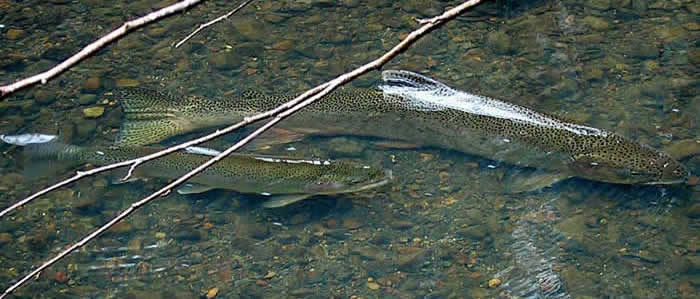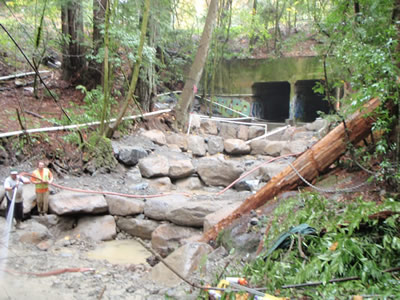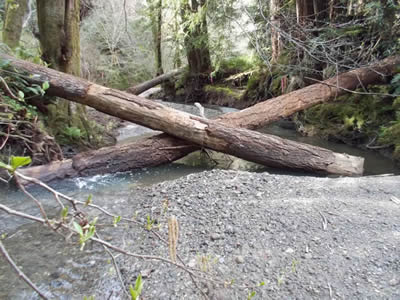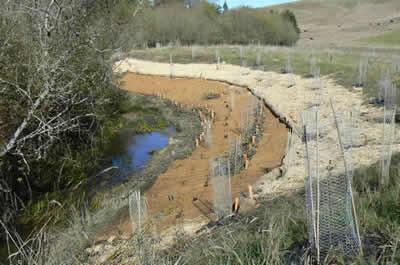Salmon Habitat
Virtually all of the Gold Ridge RCD watersheds have anadromous, salmonid fish species, primarily coho salmon and steelhead trout. Salmonids are culturally and ecologically valuable species, as major food source for humans throughout human history, and as indicators of ecosystem health; they are a keystone member of this community.

Historically, salmonid habitat has been dramatically impacted by forestry, agriculture and urban development. Roads, dams, diversions, deforestation, mining, dredging, grazing, and regrading have all directly changed the face of our district’s salmon-bearing streams in the last 200 years. Impacts that impair fish habitat include loss of water, sedimentation and crowding of spawning gravel, simplification and incising of stream channel, nutrient loading from livestock and urban development, loss of riparian forest, and barriers to fish passage.
For decades, the RCD has focused on protecting this valuable species. RCD projects that enhance habitat for salmonids include:
 Removal of Fish Passage Barriers: Salmon and other migrating fish need access to freshwater habitat for spawning and rearing. In some cases, these fish need to swim thousands of miles through the oceans and rivers to reach their destination, but they are often blocked from completing their journey by man-made barriers, such as dams and culverts. These barriers can be replaced with full span bridges or other crossings and will hopefully lead to an increase in our fish populations, returning them to levels we haven’t seen in the last few decades but hope to see again.
Removal of Fish Passage Barriers: Salmon and other migrating fish need access to freshwater habitat for spawning and rearing. In some cases, these fish need to swim thousands of miles through the oceans and rivers to reach their destination, but they are often blocked from completing their journey by man-made barriers, such as dams and culverts. These barriers can be replaced with full span bridges or other crossings and will hopefully lead to an increase in our fish populations, returning them to levels we haven’t seen in the last few decades but hope to see again.
Construction of Winter Off-Channel Habitat Refugia for Juvenile Salmonids: Projects provide the structurally complex habitat needed by juvenile salmon to survive and thrive during winter high flows–called “refugia”—habitat that once was provided by seasonally inundated, floodplain wetlands. Side channels and wetland complexes are constructed to connect the floodplain at lower (safer) flows; this off-channel habitat provides winter rearing and high flow refugia habitat for juvenile salmonids that would otherwise be swept away in high flows. Read more and see a video of the off-channel winter refugia habitat created on Green Valley Creek in 2015.
 Installation of Large Woody Debris in Stream Channel: Large wood logs, root wads, and boulders improve existing and create new fish habitat in degraded streams by providing cover, controlling sediment, add complexity to the channel, and restoring spawning and rearing habitat.
Installation of Large Woody Debris in Stream Channel: Large wood logs, root wads, and boulders improve existing and create new fish habitat in degraded streams by providing cover, controlling sediment, add complexity to the channel, and restoring spawning and rearing habitat.
Livestock Fencing: Wildlife-friendly fencing placed around streams excludes livestock from entering the riparian corridor and eroding stream banks.
Streambank Stabilization: Stabilizing the banks of streams from erosion reduces the amount of sedimentation entering the waterway and the degradation of the riparian corridor. Riparian habitats are dynamic systems, constantly gaining and losing sediment, wood, and nutrients, but streams that lose these resources too quickly become impaired and this degradation can contribute to poor water quality. Techniques for stabilizing banks include armoring the banks with large woody debris, boulders, erosion control fabric, or woven willow mattresses and by planting the banks with strong rooted plant species.
 Projects that Protect Salmon Habitat Upstream:
Projects that Protect Salmon Habitat Upstream:
Local Efforts
There are many organized local efforts underway to support the remaining populations of these fish. Gold Ridge RCD is involved in following:
The Russian River Coho Water Resources Partnership: In response to the precipitous decline of coho salmon in the Russian River watershed, the Russian River Coho Water Resources Partnership (Partnership) formed in 2009 to develop a systematic approach to improve streamflow and water supply reliability in five Russian River tributaries: Dutch Bill Creek, Grape Creek, Green Valley Creek, Mark West Creek, and Mill Creek. The Partnership is generously funded by the National Fish and Wildlife Foundation with additional support from the Sonoma County Water Agency.
University of California Cooperative Extension's Russian River Coho Salmon Recovery Program: Referred to as the "Coho Broodstock Program," this state-funded program's mission is to support salmon populations throughout the Russian River watershed by raising, releasing and monitoring coho and steelhead trout.
Save Our Salmon – The Salmon Creek Rehabilitation Program: Coho and other salmonids have been the focus of watershed restoration efforts designed to improve habitat conditions for the fish and assist in their long-term survival in coastal California. In Salmon Creek, the Gold Ridge RCD has been an important part of these efforts, conducting assessments of watershed and habitat conditions, working with local landowners on stream protection and restoration projects, and helping to inform the public about the ecological and economic importance of coho.
Gold Ridge RCD has completed a number of habitat enhancement projects and continues to make salmon habitat enhancement a priority project type.